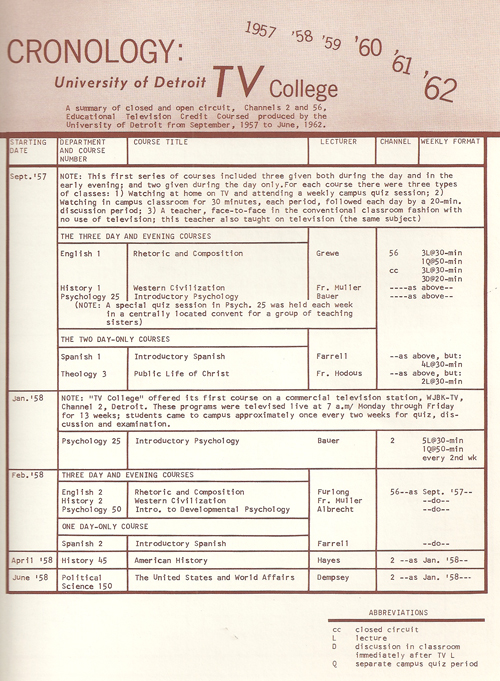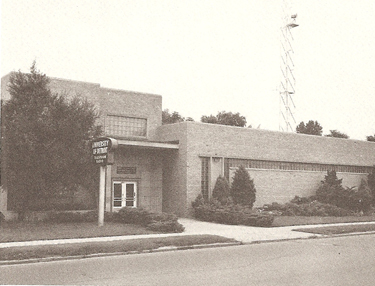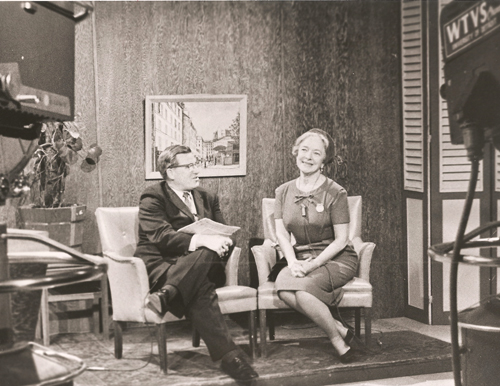Educational TV-The Early Version of Online College Classes
Back in the mid 1950′s, the University of Detroit was one of the first in the country to offer college level courses through the use of home television sets. The new television station WTVS, Channel 56, was formally dedicated November 21, 1955, by Mayor Albert E. Cobo. Remember-this was a time before there was any kind of device that you could record a TV program that could be played at a later time. You had to watch it early in the morning or later in the evening. If it was not available through the regular television stations, you might have to go through a special system that used a UHF (Ultra High Frequency) antenna. Not all TV sets had those at the time and a special antenna or converter needed to be purchased to view the program. Beginning in September 1957, five regular college courses (English, History, Psychology, Spanish 1 and Theology) were offered for credit. If students were taking the courses for credit (at an amazing tuition rate of $14.00 per hour!), they still need to come to campus once or twice a week depending on the course, to take exams or participate in discussion sessions.
Remember-this was a time before there was any kind of device that you could record a TV program that could be played at a later time. You had to watch it early in the morning or later in the evening. If it was not available through the regular television stations, you might have to go through a special system that used a UHF (Ultra High Frequency) antenna. Not all TV sets had those at the time and a special antenna or converter needed to be purchased to view the program. Beginning in September 1957, five regular college courses (English, History, Psychology, Spanish 1 and Theology) were offered for credit. If students were taking the courses for credit (at an amazing tuition rate of $14.00 per hour!), they still need to come to campus once or twice a week depending on the course, to take exams or participate in discussion sessions.
In the original plan Wayne State University of and the Board of Education owned and operated Channel 56. Cardinal Mooney and other non-public organizations objected to this arrangement and appealed to the FCC. The plan was changed to include the University of Detroit, the Parochial School System, the Public Library, the Historical Museum, and Marygrove College. Cranbrook and other similar institutions were also given a share in the venture. 
Three studios were set up-one at Wayne State University, one at the Board of Education and a third at the University of Detroit. The first studio at the University of Detroit was housed in the library, but the space was limited. A nearby building formerly the Menorah Chapel became available and could be had for $225,000. The Elmer J. Smith and Annie H. Smith Foundation purchased the property and presented the deed to Father Steiner. It was named the Smith Radio-TV Center and was dedicated on December 9, 1956. The building is no longer used by the the University and was sold in 2002.
The enrollment for courses viewed though Channel 56 during 1957-58 had 236 students, with psychology as the most popular program with 94 students. The following years, enrollment through Channel 56 saw a gradual decline. The programs were also available through closed circuit which got much more use and had as many as 1654 students by 1961-62.
Low enrollment and lack of financial support ended at-home credit coursed by 1965. The expected baby boom enrollment for college students never materialized. Perhaps the university was just a little ahead of its time. The University of Detroit Mercy now offers a number of courses that can be taken on-line.
Unfortunately, none of the tapes from the television courses have survived (or at least I do not have them anywhere in the archives). It would have been interesting to see how the courses were taught back in the fifties. This photo of an interview with Helen Hayes, a very popular actress of film and theatre, would have been nice to see.

